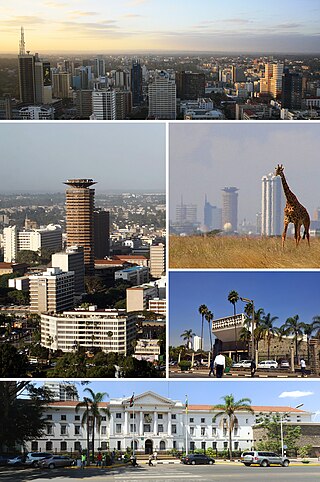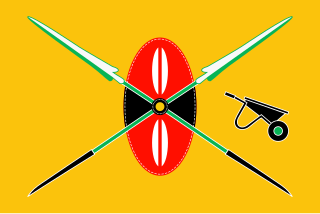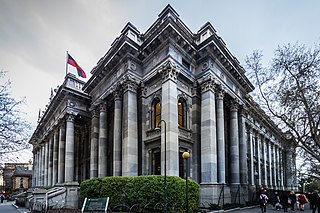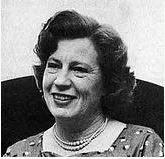
The Parliament Buildings in Nairobi are the seat of the Kenyan Parliament.

The Parliament Buildings in Nairobi are the seat of the Kenyan Parliament.

The buildings were constructed in 1954 and became the home of the colonial legislature of the Kenya Colony, the Legislative Council of Kenya, which sat there until 1963, when the council was replaced by the National Assembly. [1] The buildings, known before 1963 as the "Legislative Buildings", were designed by prominent modernist architect, Amyas Connell, and the town planning advisor to the Kenyan Colonial Government, Harold Thornley Dyer. [2] [3] The Parliament has an English-style clocktower which was a design requirement to have the Legislative Buildings echo the Palace of Westminster and Big Ben. [4]

Jomo Kenyatta, Kenya's first prime minister, is buried on the estate. [4]

Nairobi is the capital and largest city of Kenya. The name is derived from the Maasai phrase Enkare Nairobi, which translates to 'place of cool waters', a reference to the Nairobi River which flows through the city. The city proper had a population of 4,397,073 in the 2019 census. The city is commonly referred to as The Green City in the Sun.

The Kenya African National Union (KANU) is a Kenyan political party that ruled for nearly 40 years after Kenya's independence from British colonial rule in 1963 until its electoral loss in 2002. It was known as Kenya African Union (KAU) from 1944 but due to pressure from the colonial government, KAU changed its name to Kenya African Study Union (KASU) mainly because all political parties were banned in 1939 following the start of the Second World War. In 1946 KASU rebranded itself into KAU following the resignation of Harry Thuku as president due to internal differences between the moderates who wanted peaceful negotiations and the militants who wanted to use force, the latter forming the Aanake a forty, which later became the Mau Mau. His post was then occupied by James Gichuru, who stepped down for Jomo Kenyatta in 1947 as president of KAU. The KAU was banned by the colonial government from 1952 to 1960. It was re-established by James Gichuru in 1960 and renamed KANU on 14 May 1960 after a merger with Tom Mboya's Kenya Independence Movement.

The president of the Republic of Kenya is the head of state and head of government of the Republic of Kenya. The president is also the head of the executive branch of the Government of Kenya and is the commander-in-chief of the Kenya Defence Forces. The country's current president is William Ruto since 13 September 2022.

Thomas Joseph Odhiambo Mboya was a Kenyan trade unionist, educator, Pan-Africanist, author, independence activist, and statesman. He was one of the founding fathers of the Republic of Kenya. He led the negotiations for independence at the Lancaster House Conferences and was instrumental in the formation of Kenya's independence party – the Kenya African National Union (KANU) – where he served as its first Secretary-General. He laid the foundation for Kenya's capitalist and mixed economy policies at the height of the Cold War and set up several of the country's key labour institutions.

Parliament House in Brisbane is the meeting place of the Parliament of Queensland, housing its only chamber, the Legislative Assembly. It is located on the corner of George Street and Alice Street at Gardens Point in the CBD, and is next to the Queensland University of Technology and City Botanic Gardens.

Parliament House, on the corner of North Terrace and King William Road in the Adelaide city centre, is the seat of the Parliament of South Australia. It was built to replace the adjacent and overcrowded Parliament House, now referred to as "Old Parliament House". Due to financial constraints, the current Parliament House was constructed in stages over 65 years from 1874 to 1939.
Nairobi Gymkhana Club is a cricket ground and team in Nairobi, Kenya. It hosted two matches during the 2003 Cricket World Cup. The ground has a capacity of 7,000 people. It is located north of the central business district, but not far from it. The ground is the main cricket venue in the country and the only one which could in any way be described as a major ground.

Bethwell Allan Ogot is a Kenyan historian and eminent African scholar who specialises in African history, research methods and theory. One of his works starts by saying that "to tell the story of a past so as to portray an inevitable destiny is, for humankind, a need as universal as tool-making. To that extent, we may say that a human being is, by nature, historicus.

The Nairobi School is a secondary school in Nairobi, Kenya. It follows the national curriculum, is one of Kenya's 112 national schools and also one of the 18 prestigious Cluster III secondary schools.

Westlands is a mixed-use neighbourhood in Upper Parklands in Nairobi. Located 3.0 kilometres (2 mi) from Nairobi's central business district, it sits on the westerly areas of the larger Parklands area of Nairobi.

Catholic University of Eastern Africa (CUEA) is a multi-campus private university in Kenya. It is accredited by the Commission for University Education in Kenya.
South B is the name of a Division of the sub-county of Starehe in Nairobi, Kenya and the name of a "sub-location" of Mukuru Nyayo within the Division. The 2019 Kenya Census gives a population of 102,441 for South B Division and 34,216 for the sub-location. South B is about 3 kilometres (1.9 mi) south-east of Nairobi Central Business District; the Industrial Area lies to the east and the South C district to the south-west.
The Kenya High School is a public girls' high school located on Mandera Road in the upmarket Kileleshwa Ward and suburb of Dagoretti North Sub-County in Kenya's capital city, Nairobi.

The Tachoni people are one of the tribes occupying the Western and the Riftvalley regions of Kenya sharing land with the Abaluhyia, Sabaots of western and Kalenjins of the Riftvalley regions respectively. They share boundaries with the Bukusu,Kabras, Nandi and the Sabaots but widely spread out in Kenya as far as Tambach in Kerio valley, Nandi, kericho and even Mount kenya. They're also across the border to Tanzania where by one if their subgroups are there [Saniak]. They're known for their gallant defense of the Chetambe in 1895 while resisting the British rule. Tachoni people were masters of forts building such as Chetambe, Lumboka, and Kiliboti. It was their defiance of colonialism that led to the colonial government putting the entire region occupied by the Tachoni under administration of paramount chiefs drawn from the Banyala and Wanga communities since they were great resistance of the colonialists and later were forced to be merged into the luhyia community which simultaneously was a group of people who had same identies from the congo basin. Most of Tachoni lands were kept under state ownership by the colonial leadership e.g lands formerly known as white settlement schemes in former Lugari and Likuyani districts which are currently forest reserves. This was done to surpress the group and divide their unity, this being the reason why The Tachoni people lack their original lands as compared to most of the tribes in Kenya even though they're as many as other tribes in Kenya. Their division lead to extinguishment of their original language thus lead to them acquiring new breeds especially from their neighbors. Each Tachoni in different regions in the country speak different dialects to each other since they lost theirs during the colonial ruling. Sharing the land with the Abanyala, the Kabras, Nandi They live mainly in Webuye, Chetambe Hills, Ndivisi Matete sub-county-Lwandeti, Maturu, Mayoyo, Lukhokho, Kiliboti, Kivaywa, Chepsai, and Lugari sub-county in Kakamega County. Most Tachoni clans living in Bungoma speak the ' Olutachoni dialect of the Luhya language after their main dialect was fought down by the white settlers for they had resisted the whites administration. They spread to Trans-Nzoia County especially around Kitale,Kiminini, Tongaren and to Uasin Gishu County near Turbo, Soy,Ziwa, Kachibora, Moiben, Eldoret. Among the Tachoni clans are Abachikha -further divided into Abakobolo, Abamuongo, Abachambai,Abamakhanga, Abacharia, and Abakabini, Abamarakalu, Abangachi -who are further divided into: Abawaila, Abakhumaya and Abawele, Abasang'alo, Abasamo, Abayumbu, Abaluu, Abarefu,Abanyangali, Abamuchembi, Abamakhuli, Abasioya, Abaabichu,Abacheo, Abamachina,Abaengele, Abamutama, Abakafusi, Abasonge, Abasaniaka, Abaabiya also known as Abakatumi, Abakubwayi,Abakamutebi, Abakamukong, Abamweya, Abalukulu,Abawande, Abatukiika, Abachimuluku. Note that the morpheme 'aba' means 'people'. The Abakhusia/abasamo of Kabras are also Tachonis who speak Kikabras. Abayumbu and Abaluu are twin brothers, hence do not intermmary.

Nairobi City County is one of the 47 counties of Kenya. With an estimated population of 5,454,000 in 2024, it is the third smallest yet the most populous of the counties, also serving as the capital of Kenya. In 2013, the county entity was effected, replacing Nairobi City Council, the long-standing unit of administration since pre-independence. The city county consists of eleven gazetted sub-counties and eighty five electoral wards. On the national level, Nairobi also sends seventeen Members of Parliament across the constituencies and one County Woman Representative to the National Assembly; one senator to the Senate. The county government, which is allocated devolved functions as per the constitution, is headed by the county governor, who appoints his cabinet. The county's legislature is headed by the County Speaker, who presides over the County Assembly: single-member elected Members of the County Assembly (MCAs) represent their respective electoral wards. Additional MCAs are also nominated by political parties as a form of affirmative action.

Kenya National Archives and Documentation Services (KNADS) is situated at the edge of the central business district in downtown Nairobi along Moi Avenue next to Ambassadeur Hotel. The archives look out on the landmark Hilton Hotel, while on the rear side is Tom Mboya street. It was established in 1965 in a building that initially housed the Kenya Commercial Bank. It holds 40,000 volumes. It was established by an Act of the Parliament of Kenya in 1965 and was placed under the office of the Vice President and the Minister of Home Affairs. It is currently under the office of the Vice-President and State Department for National Heritage and Culture. The Kenya National Archives building also houses the Murumbi Gallery which contains African artifacts that were collected in the 19th century.

Nyayo House is a skyscraper in Nairobi, Kenya. It hosts several government departments such as immigration and also serves as the headquarters of Nairobi Province. The building is located at the corner of Uhuru Highway and Kenyatta Avenue. It is 84 metres high and has 27 floors
The following is a timeline of the history of the city of Nairobi, Kenya.

Eugenie Dorothy Hughes, was a Kenyan architect, politician, social reformer and disability activist. She founded the Kenyan Council of Social Services and served as the head of the Sports Association for the Disabled. As the first East African female architect, she owned her own firm and is best known for her design of the Cathedral of the Holy Family in Nairobi.

Kenya Electricity Transmission Company Limited, commonly referred to as KETRACO, is a wholly-owned parastatal of the Government of Kenya which serves as the primary Transmission System Operator in the Republic of Kenya.
1°17′24″S36°49′12″E / 1.2899°S 36.8200°E